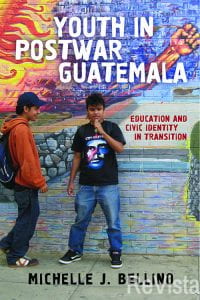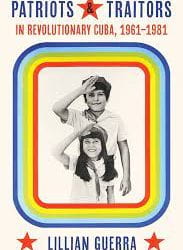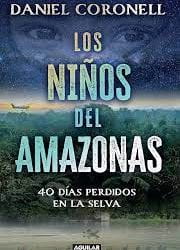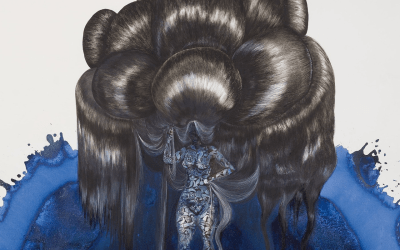A Review of Youth in Postwar Guatemala: Education and Civic Identity in Transition
Guatemalan Youth as Citizens in Waiting

Youth in Postwar Guatemala: Education and Civic Identity in Transition by Michelle J. Bellino New Brunswick: Rutgers University Press, Rutgers Series in Childhood Studies, 2017, 270 pp.
What happens when young people must simultaneously grapple with an uncertain future burdened with the legacy of conflict, violence, and impunity? Michelle Bellino provides some answers to a question that echoes throughout many conflict-affected areas, Guatemala in this case.
Presently, much media coverage about Guatemala spotlights the violence that propels many of its citizens to flee. Thus, the public image of places like Guatemala becomes synonymous with violence, danger, chaos and impunity. What these portrayals often ignore is the people— particularly the young people—who are learning to be citizens and attempt to forge a future for themselves and Guatemala. Understanding what the process of learning to be citizens in a fragile state is not as clean-cut as it may seem. Michelle Bellino’s book focuses exactly on this process by examining the multiple ways in which Guatemalan youth learn about their country’s violent history, grapple with the turbulent present, and attempt to understand their role in its future.
The idea of children and young people as the beacon of hope for the future is often invoked by many yet this rhetoric is often devoid of any concrete understanding of how young people see themselves and how they are being prepared to take on the future. Bellino’s book provides concrete examples of what this youth development process looks like.
Specifically, she examines what this process looks like for youth confronted with the reality of a fragile postwar state like Guatemala. From 1960 to 1996 Guatemala endured a civil war that is referred as the armed conflict (el conflicto armado), and the legacy of this period remains present in the lives of Guatemalan citizens, especially in the lives of its youth, Bellino notes.
Using a multi-sited ethnography, Bellino depicts how the “postwar” legacy comes alive through the education Guatemala’s youth receive and through their everyday interactions with family, friends, and others. The book is divided into eight chapters with the first two chapters discussing the impact of civil war on the current violence. Bellino also discusses the role of education in exacerbating the conflict itself, specifically by excluding indigenous groups from access to education. Moreover, through an analysis of curricular texts, Bellino finds that students were taught neutralized versions of the armed conflict that lacked discussion about the power struggles that occurred during the war.
Throughout the book, Bellino establishes the idea that Guatemalan youth are positioned as citizens in waiting or “wait citizens” (p.11). This position of “wait citizenship” allows youth to “conceive of their private autonomy over their own moral development but see little capacity to impact the broader social, political, and economic reality that they share with morally corrupt others” (p. 11).
The position of Guatemalan youth as citizens in waiting becomes animated in the next four chapters of the book which take the reader into four different schools: International Academy and Paulo Freire Institute in Guatemala City, and Sun and Moon and Tzolok Ochoch in rural areas with predominantly indigenous students. Through rich narratives, Bellino offers descriptions of the inner workings of Guatemalan history classrooms and the school hallways where students attempt to make sense about what they learn formally and what they have learned through other means. As she mentions in her introduction, Bellino also spent some time living with some of the students’ families during her ethnographic fieldwork. This allowed her to spend time outside of formal school settings with some of the youth. In effect this gave Bellino access to everyday interactions that might go unseen and form a critical piece of the extrapolation of the concept of wait citizenship.
Thus, she is able to listen as Alejandro’s mother explains why the family sees the state as the perpetuator of violence against the most vulnerable and her insights allow the reader to understand why Alejandro is frustrated with his conservative peers and teachers at the International Academy (p.46). Unlike the rest of his elite peers who travel with bodyguards, Alejandro comes from a modest background, and his parents are activists who attend protests and rallies to support indigenous rights, taking a critical stance against the state. Yet Alejandro adopts a more fatalistic view on the future of Guatemala and ultimately decides to leave the country for college.
Juxtaposed with Alejandro’s experience at the International Academy, the schooling experience of the youth attending Tzolok Ochoch focuses on recognizing the injustices the indigenous community has felt at the hands of the state. Importantly, at Tzolok Ochoch the school leaders guide their students to understand the importance of collective action to hold the state accountable to the needs of the various indigenous communities. Given the fact that Tzolok Ochoch is a rural boarding school that educates mostly indigenous students, Bellino notes that its isolated environment provides a semblance of safety away from the urban violence that affect schools like the International Academy. While the students are taught to embrace a more critical understanding of the conflicto armado, they also must realize that for their communities “postwar” justice is nothing but an elusive concept. Collective action and fighting for their pueblo allows the students of Tzolok Ochoch to challenge some of the aspects of wait citizenship.
The final two chapters of Youth in Postwar Guatemala provide an in-depth analysis and synthesis of the various themes Bellino saw throughout the four school sites. In her analysis, she shows how youth from different backgrounds, locations, and understandings of the conflicto armado are positioned as varying forms of wait citizens and how they navigate various forms of risks as well. For some waiting is the least risky option in hoping for a better Guatemala. Bellino emphasizes that “state fragility conveys to young people that the state is unwilling or unable to protect and provide for them or uphold their basic rights” (p.205). As such, Guatemalan youths’ lives “have come to increasingly be defined by the risks they are willing to take and the precautions they apply to mediate those risks” (p. 210).
While some students, like Alejandro, take on more fatalistic views on how collective action can create a better Guatemala, others—like the students of Tzolok Ochoch—are taught that hope lies in collective action. Both stances produce varying forms of risks for students. A fatalistic view can lead some to further disengage with the state and seek options outside of it. Collective action can expose students to violence and retaliation from those who continue to oppress vulnerable communities. Ultimately, the Guatemalan youth in this study grapple with a history that is ever-present in their daily lives while they hope and wait for a better future.
Bellino ends by emphasizing that Guatemalan youth continue to wait. Although this might be true for some, the reality for a few others is that instead of waiting they have chosen to flee. The number of Guatemalan youth crossing multiple borders to flee the dire conditions of the country reminds us all that there is only so much waiting one can risk when life is on the line. Bellino’s book can serve as an introduction for those seeking to understand what propels many Guatemalan migrant youth to leave. For many of these young migrants waiting is no longer a risk they are able to take.
Fall 2018, Volume XVIII, Number 1
Martha C. Franco is a Ph.D. student at Harvard University. Her research focuses on how Central American unaccompanied minors are incorporated into U.S. public schools and the nation more broadly. You can often find her searching for the best Salvadoran coffee in town.
Related Articles
A Review of Patriots and Traitors in Revolutionary Cuba, 1961-1981
I remember when I first heard Lillian Guerra speak: over fifteen years ago, at Brown University, about her third book, Visions of Power in Cuba: Revolution, Redemption and Resistance (1959-1971).
A Review of Los Niños del Amazonas: 40 Días Perdidos en la Selva
Los niños del Amazonas. 40 días perdidos en la selva is the first true book by Colombian journalist Daniel Coronell, whose long and impressive career speaks for itself: news director of manifold networks; recipient of prestigious recognitions such as Emmys, Peabodys and Simón Bolívar prizes; and arguably the most widely read columnist in Colombia, where he is as much admired as he is feared.
A Review of Channeling Knowledges: Water and Afro-Diasporic Spirits in Latinx and Caribbean Worlds
Water is a powerful tenet of Afro-diasporic religions that troubles academic disciplines and racial categories that define state, military and geographic borders.




